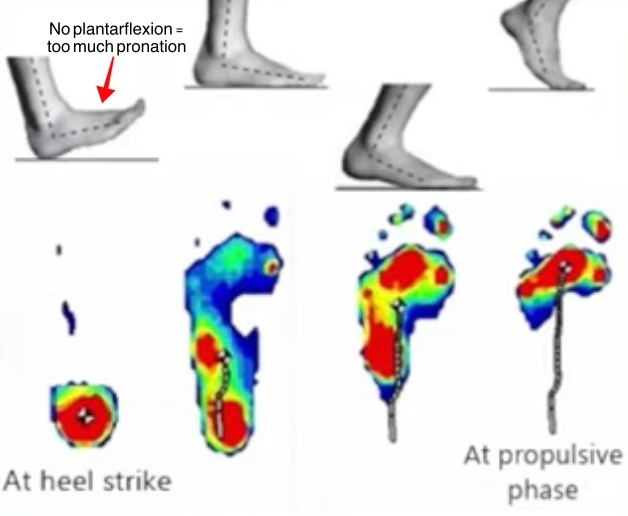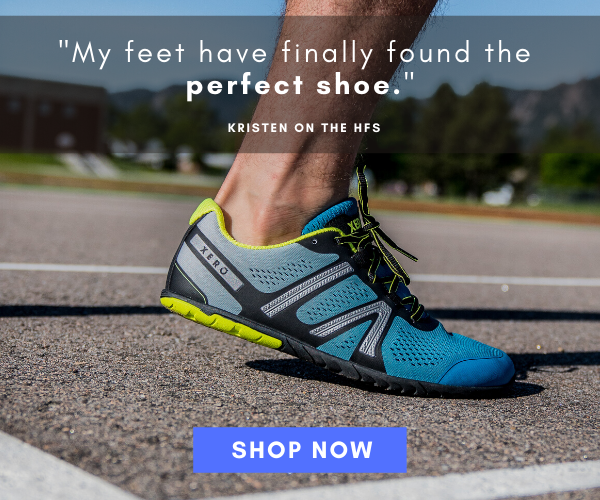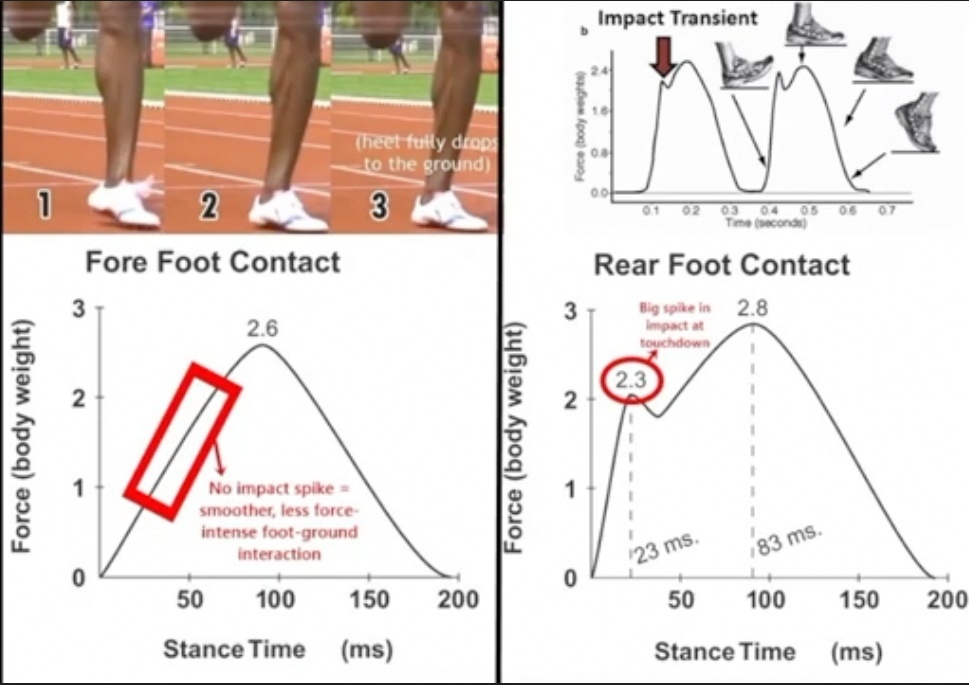The hips are increasingly likely to be injured in heel strike running because it negatively affects how the foot interacts with the ground in ways that result in more stressed aspects on the leg, hips included as compared with forefoot running.

For one, at heel strike, there’s no plantarflexion (shown below) which was found to increase pronation (side-to-side motions of the heel). For another, the line of travel of the body weight over the foot when the foot rolls heel-to-toe was found to produce greater than normal pressure on the foot, causing the center of pressure to become so high on the foot that the foot is required to shift too far outward.


Essentially, heel striking when running is one of the main causes of over-pronation, which is when the foot is turned away excessively from its neutral line. This leads to misalignment of the foot and leg, and can severely stress the hips because the transfer of foot overpronation to the leg increases rotational stress and bending strain on the hips as well as the IT band.

Worse still, another stressor on the hips in heel strike running is the ground reaction force at landing exceeds several times the body weight, which is a classic feature of heel striking that has been blamed for nearly all the injuries in running. This impact sends a shock-wave up the leg, which increases the amount of loading on the hips and strikes other parts of the body as well, even causing structural damage to the lower back!
All in all, the most important takeaway is the reason you cant overcome your hip pain as a runner may be because your feet are pronating too much because you are heel striking, not forefoot striking!
Forefoot running eases the burden on the hips by having more influence on constraining pronation, keeping it in a safer range because the movement path of the foot after landing makes a shorter, faster travel from forefoot-to heel which reduces the chance of the foot to alter from its neutral line during stance.
Also, landing with a forefoot strike naturally engages more plantarflexion (shown above left), meaning there’s a larger foot contact area that not only allows for more landing stability, but it disperses impact pressure on a wider surface area over the foot. In fact, plantar pressure spreads best with this landing configuration because there’s no point on the foot that gets a heavy burst of impact pressure delivered to it. This also means the foot is required to pronate less which essentially reduces the amount of mechanical work needed from the foot as compared with heel strike running.
Last but not least, forefoot running doesn’t just work best for fixing over-pronation, it also naturally engages safer, more optimal knee mechanics that reduces the damaging forces behind shin fracture, lower back pain and runners knee. Here is my article on that!
If you’ve enjoyed my post, you’ll love my content over at my YouTube channel, here, where you’ll learn more about why forefoot running is better than heel strike running in every way as well as why running barefoot can make you run significantly better in shoes!

References:
Weinstein, SM. Running & FitNews, 2015; 33(5):19-23.
If you’d like, you can support Run Forefoot and help keep it going by making a donation in any amount of your choosing:

Or, you can support Run Forefoot by shopping at the BEST Barefoot Shoe Brands, and be sure to bookmark these links 🙂
Lonowear: https://lonowear.com/?ref=cedsholh
Saguaro: https://www.saguaro.com/?ref=9bVA8fEkmDvB-I
Vibram FiveFingers: https://www.anrdoezrs.net/click-7600968-11372648
Vivobarefoot: https://amzn.to/3vycQOY
Be Lenka: https://www.tkqlhce.com/click-7600968-13947200
Xero Shoes: https://xeroshoes.com/go/Run_Forefoot
Iguaneye: https://www.iguaneye.com/?ref=8tfXVc92
Soft Star Shoes: https://shrsl.com/3mp1b
Wilding Shoes: https://bit.ly/3lIygQP
Bretta Riches
BSc Neurobiology; MSc Biomechanics candidate, ultra minimalist runner & founder of RunForefoot. I was a heel striker, always injured. I was inspired by the great Tirunesh Dibaba to try forefoot running. Now, I'm injury free. This is why I launched Run Forefoot, to advocate the health & performance benefits of forefoot running and to raise awareness on the dangers of heel striking, because the world needs to know.
Latest posts by Bretta Riches (see all)
- Can You Run In Barefoot Shoes? Yes, But DON’T Heel Strike! - 21/07/2024
- Why Cushioned Running Shoes Are Really Bad for Your Feet - 19/07/2024
- Do Cushioned Running Shoes Cause Injuries? - 17/07/2024

